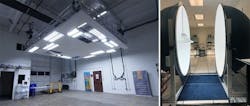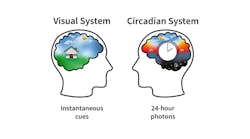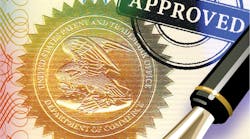Commercially-available luminaires sold with efficacy claims in the 200-lm/W range deliver mixed results in US Department of Energy testing at PNNL, with glare being a recurring issue and most products falling short of efficacy specifications.
The US Department of Energy (DOE) has released a short report covering testing of rectilinear LED luminaires intended for high-output applications such as low- and high-bay lighting in industrial or commercial settings. The testing was focused on seven solid-state lighting (SSL) luminaires that had been touted by manufacturers to deliver efficacy in the range of 200 lm/W. The mixed results include measured photometric performance and subjective analysis for visual comfort and acuity under the lighting.
Interested in articles & announcements on indoor LED lighting and lighting test reports?
The testing took place at the DOE’s Pacific Northwest National Laboratory (PNNL) where researchers sought to verify high-efficacy performance and discover any subjective or measured performance issues that resulted from manufacturers pushing the lumen output to high levels. The project included measurements made in an integrating sphere and input from what were described as “23 knowledgeable observers.”
At first glance, the work seemed to resemble one of the many Caliper test projects that the DOE has performed over the years but has seemingly performed less frequently of late. Those tests involved detailed hands-on testing of commercially-available luminaires. It seems the last such Caliper report that we covered was on OLEDs in late 2016.
A new report by the US Department of Energy (DOE) evaluated indoor high- and low-bay LED luminaires at the Pacific Northwest National Laboratory (PNNL). (Photo credits: PNNL.)
More recently, the DOE has issued Caliper Snapshot reports that rely on data from the LED Lighting Facts database as opposed to hands-on laboratory testing at a DOE lab. For example, the DOE issued a Caliper Snapshot report on troffer luminaires in early 2017. This new report style is perhaps a hybrid of the older Caliper and Caliper Snapshot projects that don’t require the deep funding of the full Caliper reports.
For this latest research, the PNNL researchers found five of the test products using the Lighting Facts database. Note that the DOE no longer directly controls that database but was responsible for its creation. The researchers located the other two fixtures via an online search and ordered a pair of each of the seven anonymously for the testing.
The 200-lm/W level has been considered the next milestone for efficacy. Packaged LEDs surpassed that level several years back, but luminaires have struggled to surpass the milestone at the system level given losses in the driver electronics and optical losses.
The DOE said all but one of the tested products exposed the individual LED emitters. Presumably, such a design would minimize optical losses while possibly increasing glare. The tested products were specified at a 5000K CCT.
The full report on the DOE SSL website identifies the luminaires tested and the detailed characterization of each. The researchers found that across the group, lumen output varied by no more than 9.6% and power consumed by no more than 6.8% relative to manufacturers’ specifications. Of course, efficacy is a ratio of those characteristics meaning that worst-case efficacy trailed the stated specification by as much as 12%. Still, the DOE pointed out that Lighting Facts data is based on the best-performing luminaire in a product family that might include products with different CCTs and other characteristics. Reading between the lines, you could draw the conclusion that the tested products delivered on manufacturer specifications.
The subjective testing, however, generally produced worse results. Only two of the products received acceptable ratings for visual comfort and overall light quality. One was the single product that included a diffusing optic as opposed to exposing the emitters, and the second has an optical design that cuts off the beam at higher angles to reduce glare.
The top-ranked luminaire also was the lowest-performing product in terms of efficacy — delivering only 136 lm/W. That is significantly under the target 200-lm/W range yet is indicative of the growing trend that the lighting industry should trade off some energy efficiency for better light quality (and previous contributors have voiced concern that efficacy and energy efficiency were being prioritized over quality of light and distribution).
The DOE also pointed out that there remains a significant efficacy penalty associated with warmer CCTs. The project tested 5000K luminaires because that CCT is typical of what would be deployed in the intended application. But the researchers said that in the case of manufacturer specifications for the seven tested products, moving to 3000K-CCT products would result in a 17% efficacy drop.
*Updated July 30, 2018 1:35 PM for addition of manufacturers/luminaires included in the full report.






